英语人教版七年级上册My name is Jina
- 格式:doc
- 大小:30.00 KB
- 文档页数:4
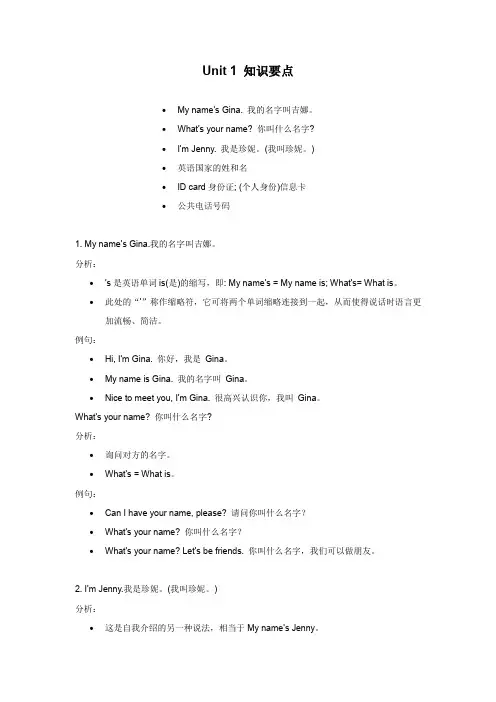
Unit 1 知识要点•My name's Gina. 我的名字叫吉娜。
•What's your name? 你叫什么名字?•I'm Jenny. 我是珍妮。
(我叫珍妮。
)•英语国家的姓和名•ID card身份证; (个人身份)信息卡•公共电话号码1. My name's Gina.我的名字叫吉娜。
分析:•'s是英语单词is(是)的缩写,即: My name's = My name is; What's= What is。
•此处的“'”称作缩略符,它可将两个单词缩略连接到一起,从而使得说话时语言更加流畅、简洁。
例句:•Hi, I'm Gina. 你好,我是Gina。
•My name is Gina. 我的名字叫Gina。
•Nice to meet you, I'm Gina. 很高兴认识你,我叫Gina。
What's your name? 你叫什么名字?分析:•询问对方的名字。
•What's = What is。
例句:•Can I have your name, please? 请问你叫什么名字?•What's your name? 你叫什么名字?•What's your name? Let's be friends. 你叫什么名字,我们可以做朋友。
2. I'm Jenny.我是珍妮。
(我叫珍妮。
)分析:•这是自我介绍的另一种说法,相当于My name's Jenny。
•I'm为I am的缩写。
•I'm … 是本单元一个重要的句型,它的含义是“我....。
例如:I'm your teacher. 我是你的老师。
I'm a new student. 我是一位新学生。
例句:•I'm Jenny. 我是珍妮。
•My name is Jenny. 我叫珍妮。
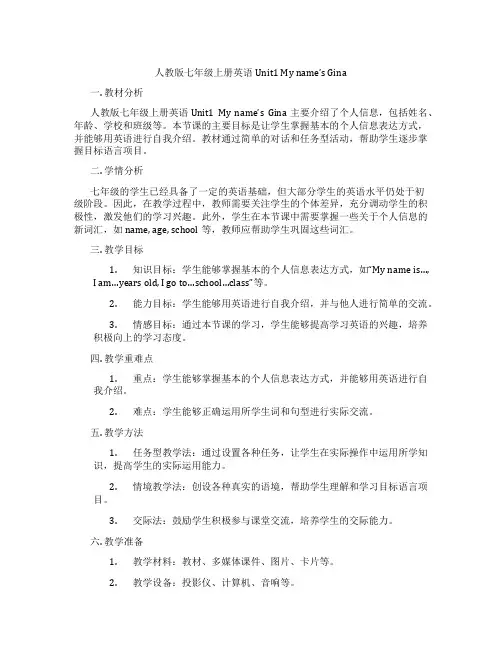
人教版七年级上册英语Unit1 My name’s Gina一. 教材分析人教版七年级上册英语Unit1 My name’s Gina主要介绍了个人信息,包括姓名、年龄、学校和班级等。
本节课的主要目标是让学生掌握基本的个人信息表达方式,并能够用英语进行自我介绍。
教材通过简单的对话和任务型活动,帮助学生逐步掌握目标语言项目。
二. 学情分析七年级的学生已经具备了一定的英语基础,但大部分学生的英语水平仍处于初级阶段。
因此,在教学过程中,教师需要关注学生的个体差异,充分调动学生的积极性,激发他们的学习兴趣。
此外,学生在本节课中需要掌握一些关于个人信息的新词汇,如name, age, school等,教师应帮助学生巩固这些词汇。
三. 教学目标1.知识目标:学生能够掌握基本的个人信息表达方式,如“My name is…,I am…years old, I go to…school…class”等。
2.能力目标:学生能够用英语进行自我介绍,并与他人进行简单的交流。
3.情感目标:通过本节课的学习,学生能够提高学习英语的兴趣,培养积极向上的学习态度。
四. 教学重难点1.重点:学生能够掌握基本的个人信息表达方式,并能够用英语进行自我介绍。
2.难点:学生能够正确运用所学生词和句型进行实际交流。
五. 教学方法1.任务型教学法:通过设置各种任务,让学生在实际操作中运用所学知识,提高学生的实际运用能力。
2.情境教学法:创设各种真实的语境,帮助学生理解和学习目标语言项目。
3.交际法:鼓励学生积极参与课堂交流,培养学生的交际能力。
六. 教学准备1.教学材料:教材、多媒体课件、图片、卡片等。
2.教学设备:投影仪、计算机、音响等。
七. 教学过程1.导入(5分钟)教师通过展示一张学生的照片,引导学生猜测照片中的人是谁,从而引出本节课的主题——介绍个人信息。
2.呈现(10分钟)教师展示教材中的插图,引导学生观察图中的人物,并根据图中的提示,让学生尝试说出人物的姓名、年龄、学校和班级等信息。
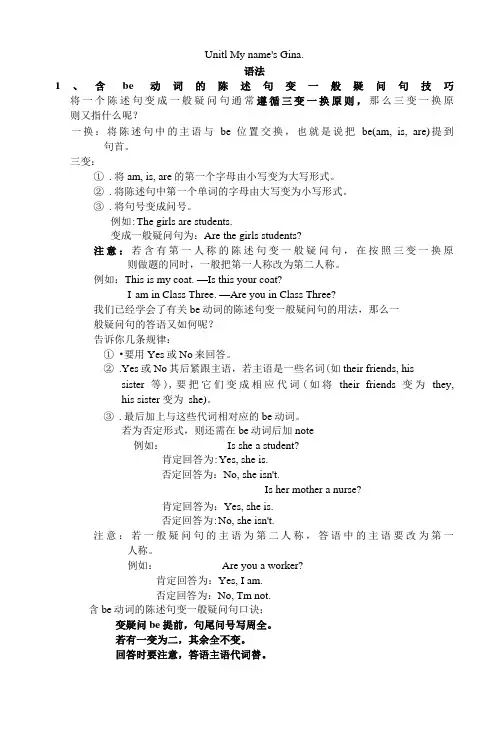
Unitl My name's Gina.语法1、含be动词的陈述句变一般疑问句技巧将一个陈述句变成一般疑问句通常遵循三变一换原则,那么三变一换原则又指什么呢?一换:将陈述句中的主语与be位置交换,也就是说把be(am, is, are)提到句首。
三变:①.将am, is, are的第一个字母由小写变为大写形式。
②.将陈述句中第一个单词的字母由大写变为小写形式。
③.将句号变成问号。
例如:The girls are students.变成一般疑问句为:Are the girls students?注意:若含有第一人称的陈述句变一般疑问句,在按照三变一换原则做题的同时,一般把第一人称改为第二人称。
例如:This is my coat. —Is this your coat?I am in Class Three. —Are you in Class Three?我们已经学会了有关be动词的陈述句变一般疑问句的用法,那么一般疑问句的答语又如何呢?告诉你几条规律:①•要用Yes或No来回答。
②.Yes或No其后紧跟主语,若主语是一些名词(如their friends, hissister等),要把它们变成相应代词(如将their friends变为they,his sister 变为she)。
③.最后加上与这些代词相对应的be动词。
若为否定形式,则还需在be动词后加note例如:Is she a student?肯定回答为:Yes, she is.否定回答为:No, she isn't.Is her mother a nurse?肯定回答为:Yes, she is.否定回答为:No, she isn't.注意:若一般疑问句的主语为第二人称,答语中的主语要改为第一人称。
例如:Are you a worker?肯定回答为:Yes, I am.否定回答为:No, Tm not.含be动词的陈述句变一般疑问句口诀:变疑问be提前,句尾问号写周全。
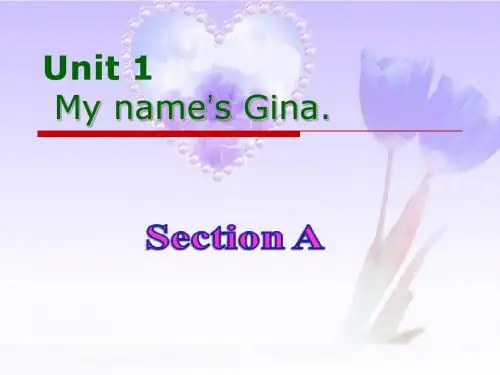
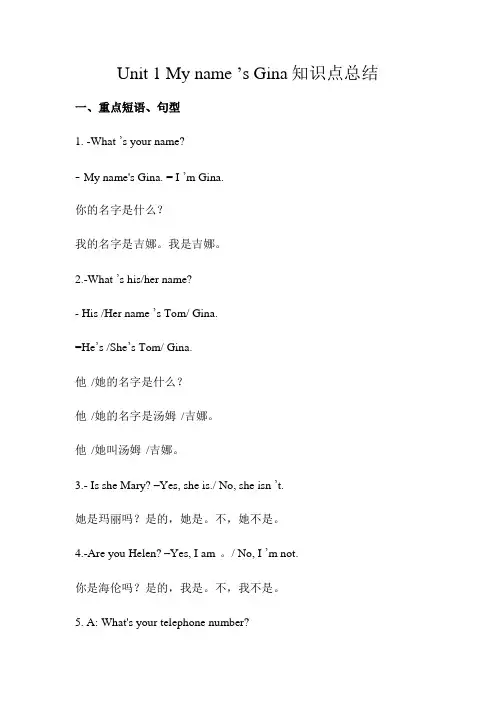
Unit 1 My name ’s Gina知识点总结一、重点短语、句型1. -What ’s your name?- My name's Gina. = I ’m Gina.你的名字是什么?我的名字是吉娜。
我是吉娜。
2.-What ’s his/her name?- His /Her name ’s Tom/ Gina.=He’s /She’s Tom/ Gina.他/她的名字是什么?他/她的名字是汤姆/吉娜。
他/她叫汤姆/吉娜。
3.- Is she Mary? –Yes, she is./ No, she isn ’t.她是玛丽吗?是的,她是。
不,她不是。
4.-Are you Helen? –Yes, I am 。
/ No, I ’m not.你是海伦吗?是的,我是。
不,我不是。
5. A: What's your telephone number?B: My phone number is 281-9176.It's 281-9176.你的电话号码是多少?我的电话号码是281-9176 。
6. -Nice to meet/see you. -Nice to meet/see you, too. 见到你很高兴。
见到你也很高兴 .st name=family name=last name 姓氏8.first name = given name 名字9.telephone number=phone number 电话号码二、交际用语(一)常见的问候表达方式有:1、Hello/Hi2、Good morning/afternoon/evening/night3、Nice to meet you/Nice to meet you, too4、How are you?5、How do you do?(二)常见的介绍表达方式有:1. I ’ m… /My name ’ s… /This is … /These are … and….2. Nice to meet you.3. What ’ s your phone number?4. It ’ s 2842942.三、语法1、be 的一般现在时形式2、What 引导的特殊疑问句3、形容词性物主代词:my ,your,his,her四、知识点1.My name ’ s Jenny.我的名字叫詹尼。
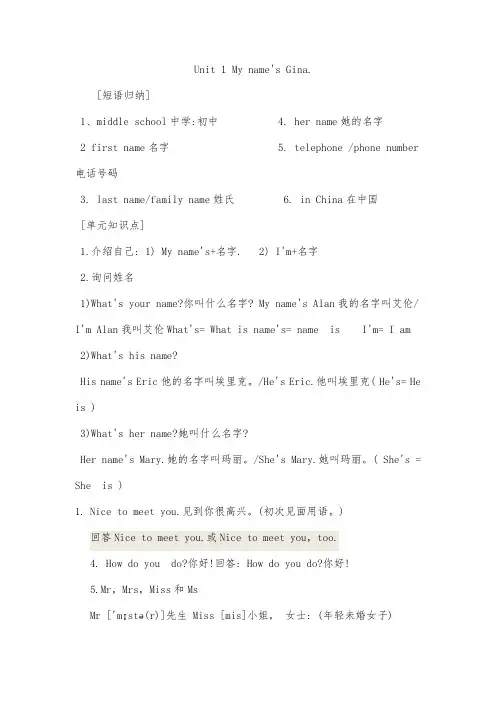
Unit 1 My name's Gina.[短语归纳]1、middle school中学:初中 4. her name她的名字2 first name名字 5. telephone /phone number 电话号码3. last name/family name姓氏 6. in China在中国[单元知识点]1.介绍自己: 1) My name's+名字. 2) I'm+名字2.询问姓名1)What's your name?你叫什么名字? My name's Alan我的名字叫艾伦/ I'm Alan我叫艾伦What's= What is name's= name is I'm= I am 2)What's his name?His name's Eric他的名字叫埃里克。
/He's Eric.他叫埃里克( He's= He is )3)What's her name?她叫什么名字?Her name's Mary.她的名字叫玛丽。
/She's Mary.她叫玛丽。
( She's = She is )1.Nice to meet you.见到你很高兴。
(初次见面用语。
)回答Nice to meet you.或Nice to meet you,too.4. How do you do?你好!回答: How do you do?你好!5.Mr,Mrs,Miss和MsMr ['mɪstə(r)]先生 Miss [mis]小姐,女士: (年轻未婚女子)Mrs ['misiz]太太: 夫人(用于已婚妇女姓名前) Ms. [miz]女士6. Ishe Jack?他是杰克吗? Yes, he is.是的,他是。
No, he isn't, His name's Mike.不,他不是。
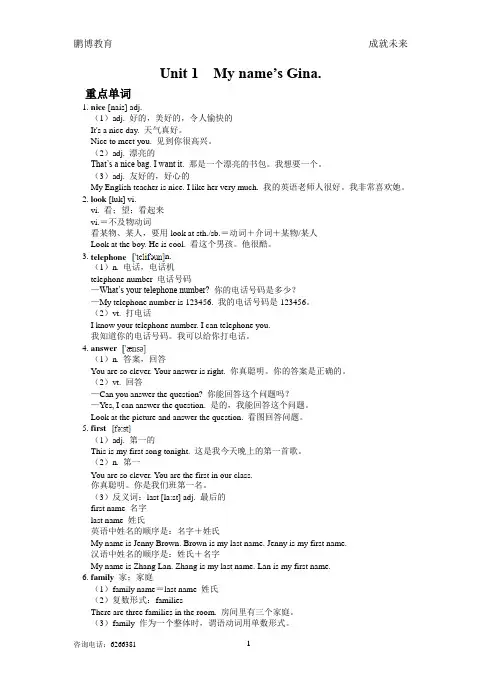
Unit 1 My name’s Gina.重点单词1. nice [nais] adj.(1)adj. 好的,美好的,令人愉快的It's a nice day. 天气真好。
Nice to meet you. 见到你很高兴。
(2)adj. 漂亮的That’s a nice bag. I want it. 那是一个漂亮的书包。
我想要一个。
(3)adj. 友好的,好心的My English teacher is nice. I like her very much. 我的英语老师人很好。
我非常喜欢她。
2. look [luk] vi.vi. 看;望;看起来vi.=不及物动词看某物、某人,要用look at sth./sb.=动词+介词+某物/某人Look at the boy. He is cool. 看这个男孩。
他很酷。
3. telephone n.(1)n. 电话,电话机telephone number 电话号码—What’s your telephone number? 你的电话号码是多少?—My telephone number is 123456. 我的电话号码是123456。
(2)vt. 打电话I know your telephone number. I can telephone you.我知道你的电话号码。
我可以给你打电话。
4. answer(1)n. 答案,回答You are so clever. Your answer is right. 你真聪明。
你的答案是正确的。
(2)vt. 回答—Can you answer the question? 你能回答这个问题吗?—Yes, I can answer the question. 是的,我能回答这个问题。
Look at the picture and answer the question. 看图回答问题。
5. first(1)adj. 第一的This is my first song tonight. 这是我今天晚上的第一首歌。
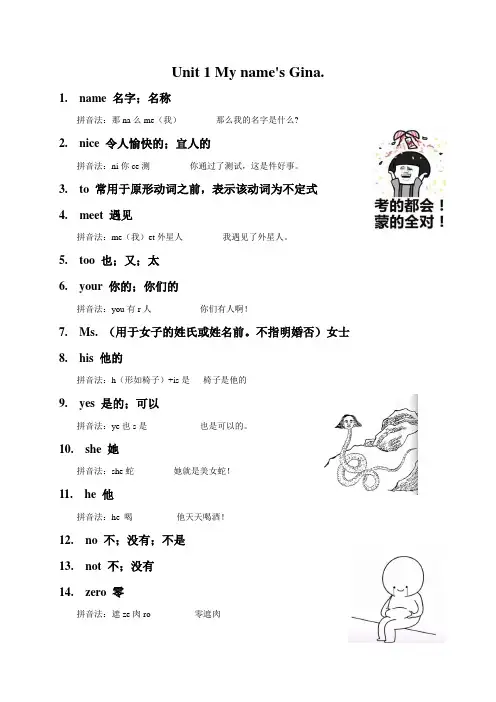
Unit 1 My name's Gina. 1. name 名字;名称拼音法:那na么me(我)那么我的名字是什么?2. nice 令人愉快的;宜人的拼音法:ni你ce测你通过了测试,这是件好事。
3. to 常用于原形动词之前,表示该动词为不定式4. meet 遇见拼音法:me(我)et外星人我遇见了外星人。
5. too 也;又;太6. your 你的;你们的拼音法:you有r人你们有人啊!7. Ms. (用于女子的姓氏或姓名前。
不指明婚否)女士8. his 他的拼音法:h(形如椅子)+is是椅子是他的9. yes 是的;可以拼音法:ye也s是也是可以的。
10. she 她拼音法:she蛇她就是美女蛇!11. he 他拼音法:he 喝他天天喝酒!12. no 不;没有;不是13. not 不;没有14. zero 零拼音法:遮ze肉ro 零遮肉15. one 一拼音法:o哦ne呢哦呢是一。
拼音法:o鸡蛋ne呢一个鸡蛋呢?16. two 二拼音法:t踢wo我踢我是二17. three 三拼音法:th土豪re热e饿三个土豪又热又饿。
18. four 四拼音法:fou否r认否认得了4分。
19. five 五拼音法:f烦i我v五e鹅烦我的五只鹅。
拼音法:f佛i我ve维生素E 佛给我维生素E。
20. six 六拼音法:si四x XXXX是六,一个X是多少?21. seven 七拼音法:s是e鹅v五en嗯七是鹅,排老五,嗯。
22. eight八拼音法:e鹅+i我+ght桂花糖八是鹅和我抢桂花糖。
23. nine 九拼音法:你ni呢ne (九)就是你呢。
24. telephone 电话;电话机音背法:太乐风拼音法:tele特乐ph排行one第一特乐排行第一的就是电话。
词根词缀法:tele电+phone电话25. number 号码;数字拼音法:n你u有mb每班er的人你有每个班级的人的号码吗?。
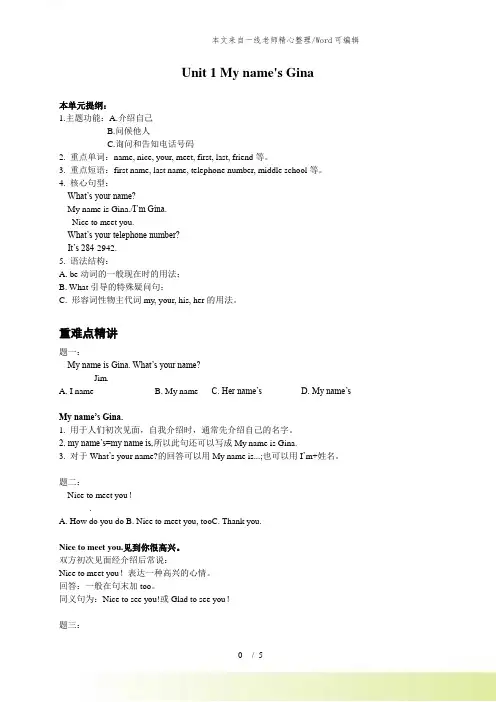
Unit 1 My name's Gina本单元提纲:1.主题功能:A.介绍自己B.问候他人C.询问和告知电话号码2. 重点单词:name, nice, your, meet, first, last, friend等。
3. 重点短语:first name, last name, telephone number, middle school等。
4. 核心句型:---What’s your name?---My name is Gina./I’m Gina.Nice to meet you.---What’s your telephone number?---It’s 284-2942.5. 语法结构:A. be动词的一般现在时的用法;B. What引导的特殊疑问句;C. 形容词性物主代词my, your, his, her的用法。
重难点精讲题一:---My name is Gina. What’s your name?---______Jim.A. I nameB. My nameC. Her name’sD. My name’sMy name’s Gina.1. 用于人们初次见面,自我介绍时,通常先介绍自己的名字。
2. my name’s=my name is,所以此句还可以写成My name is Gina.3. 对于What’s your name?的回答可以用My name is...;也可以用I’m+姓名。
题二:---Nice to meet you!---_____.A. How do you doB. Nice to meet you, tooC. Thank you.Nice to meet you.见到你很高兴。
双方初次见面经介绍后常说:Nice to meet you!表达一种高兴的心情。
回答:一般在句末加too。
同义句为:Nice to see you!或Glad to see you!题三:---What’s her telephone number?---__________.A. It’s 786-1356B. It’s Jim@C. I’m 88567301What’s your......number?用来询问电话、房间、身份证等号码的常用句型,回答时可用It’s.....或直接说出号码。
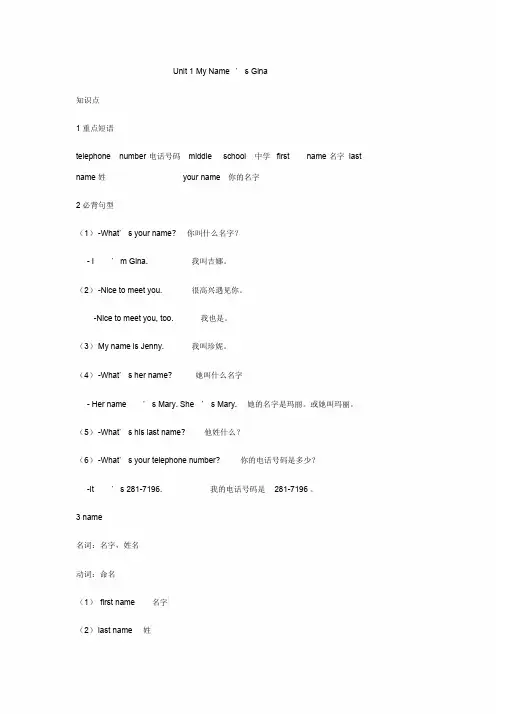
Unit 1 My Name ’s Gina知识点1 重点短语telephone number 电话号码middle school 中学first name 名字last name 姓your name 你的名字2 必背句型(1)-What’s your name? 你叫什么名字?- I ’m Gina. 我叫吉娜。
(2)-Nice to meet you. 很高兴遇见你。
-Nice to meet you, too. 我也是。
(3)My name is Jenny. 我叫珍妮。
(4)-What’s her name? 她叫什么名字- Her name ’s Mary. She ’s Mary. 她的名字是玛丽。
或她叫玛丽。
(5)-What’s his last name? 他姓什么?(6)-What’s your telephone number? 你的电话号码是多少?-It ’s 281-7196. 我的电话号码是281-7196 。
3 name名词:名字,姓名动词:命名(1)first name 名字(2)last name 姓*国外的名和姓的顺序与中国相反,一般是名字在前面,姓氏在后面。
在中国,一般是姓氏在前面,名字在后面。
并且姓和名之间要有一个空格,需并且姓和名的首字母都要大写,但是名有两个字的话,中间不加空格,只姓和名的首字母大写。
亮Z hang Xiaoliang 张晓如:Zhang Liang 张亮4 be 动词的使用be 动词的用法口诀(he) ,她(she) ,它(it) ;我(I) 用am,你(you) 用are ,is 连着他单数名词用is ,复数名词全用are 。
弃。
变疑问,往前提,句末问号莫丢变否定,更容易,be 后not 莫忘记。
疑。
疑问否定任你变,句首大写莫迟(1)be 动词(am, is are )在句子中做连系动词,连接主语和表语。
I am a girl. 我是女孩。
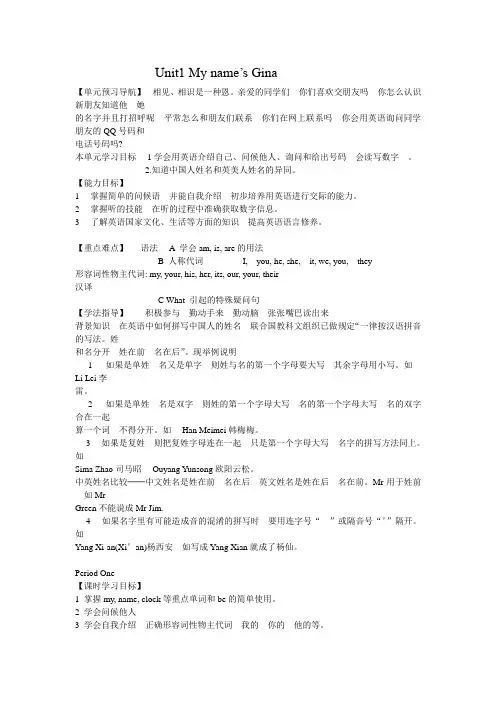
Unit1 My name’s Gina【单元预习导航】的名字并且打招呼呢朋友的QQ号码和电话号码吗?本单元学习目标1学会用英语介绍自己、问候他人、询问和给出号码2.知道中国人姓名和英美人姓名的异同。
【能力目标】123【重点难点】语法 A 学会am, is, are的用法B 人称代词I, you, he, she, it, we, you, they形容词性物主代词: my, your, his, her, its, our, your, their汉译C What 引起的特殊疑问句【学法指导】背景知识的写法。
姓和名分开1Li Lei李雷。
2合在一起算一个词Han Meimei韩梅梅。
3的拼写方法同上。
如Sima Zhao司马昭Ouyang Yunsong欧阳云松。
中英姓名比较──中文姓名是姓在前Mr用于姓前MrGreen不能说成Mr Jim.4Yang Xi-an(Xi’an)杨西安Yang Xian就成了杨仙。
Period One【课时学习目标】1 掌握my, name, clock等重点单词和be的简单使用。
2 学会问候他人3 学会自我介绍---我的【重点难点】掌握人称代词的用法【学法指导】多读多写【自主学习】重点词汇1名字__________2时钟__________3好的___________4遇见___________5什么__________6__________7看_________8第一的__________9我的________10他的________11她的__________12 你的___________13你___________14女孩__________15男孩__________16 詹尼___________17吉娜___________18艾伦________19玛丽_________20托尼_________重点短语 1.我/你/她/他/的名字_____________________2.问候其他的学生___________________3 回答问题_________________________4看…___________5他的问题________________________6 对不起/打扰一下________________________重点句型 1.你叫什么名字___________________________________________ 我叫吉娜。
Unit 1 My name’s GinaI. Sentence Patterns(句型)1.[What is = What’s ] your / his / her / its name?答句:My / His / Her / Its [name is = name’s] ...同义句:[I am =I’m ] / [He is = He’s] / [She is = She’s] / [ It is= It’s] ... 2.Is she / he / it...?答句: Yes, he / she / it is.No, he / she / it [is not = isn’t]. [He / She / It is = He’s / She’s / It’s]… .3.Are you...?答句:Yes, I am. / No, [I am = I’m] not. [I am = I’m]… .4.Nice to meet you! = Glad to see you!答语:Nice to see you, too!5.[What’s = What is] your / his / her [telephone = phone] number?答语:My / His / Her [telephone = phone] number is...或者:[It’s = It is] … .II. Words and Phrases(词汇和短语)A. Name list(名单)(音标自己补充)a. First name / Family name / Surname(姓氏):1. Brown 布朗2. Miller 米勒3. Green 格林4. Smith 史密斯b. Girl’s name(女名):1. Gina 吉娜2. Jenny 珍妮3. Mary 玛丽4. Linda 琳达5. Jane 简c. Boy’s name(男名):1. Alan 艾伦2. Tom 汤姆3. Mike 迈克4. Jack 杰克B. Phrases(短语):1. telephone number = phone number 电话号码2. full name 全名(= first name + last name)3. last name = family name = surname 姓氏4. first name = given name 名字5. middle school 中学;初中6. high school 中学junior high school 初中senior high school 高中7. in China 在中国III. Grammar(语法)A. Abbreviations(缩写)1. what’s = what is2. name’s = name is3. I’m = I am4. he’s = he is5. she’s = she is6. it’s = it isB. Pronouns(代词):代词是代替名词的词。
信息技术教学设计Unit 1 My name is Gina朱莉The First Period (Section A, 1a–2d) 教学设计Teaching aims(教学目标)1.知识与能力采用Practicing, Listening for specific information和Role playing的学习策略,使学生学会打招呼和介绍自己、询问他人姓名的基本句型What's your/his/her name?My/His/Her name is…。
‖培养学生结交新朋友的能力。
2.过程与方法采用Practicing, Listening for specific information和Role playing的学习策略,展开课堂Pair work; Group work的口语交际活动,询问他人姓名、了解有关姓名的文化知识并制作个性名片。
3.情感态度价值观该部分学习内容贴近学生的生活,谈论的主题是结交新朋友,进一步促进学生之间的相互了解,使学生在轻松、愉快的学习氛围中熟识新伙伴,增进友谊。
Language points(语言点)1.要求掌握以下句式:What’s you r/his/her first name?What’s your/his/her last name?2.要求掌握以下词汇:first name, last name, family name, given name, boys and girls1.要求掌握以下句式:(1)—What’s your name?—My name is …(2)—Hello! I’m Mary.—Hi, Mary! I’m Jim. Nice to meet you.(3)what’s =what is; I’m =I am; name’s =name is2.要求掌握以下词汇:(1)生词:name, clock, am, nice, meet, what, hello(2)人称代词和形容词性物主代词:I, you, my, your, his, her(上述数词和部分形容词性物主代词本应在第二和第三课时中出现,但可以在第一课时中非正式出现,给学生初步的印象,为后面的学习作铺垫。
)Difficulties(难点):本课难点是大量的人名和形容词性物主代词,而学生在描述时容易混淆男名和女名,在运用代词时容易错用人称代词和物主代词。
Teaching steps (教学步骤)Lead in:Good morning/afternoon,everyone! Last week, we finished the first part of this English book -Starter Units 1–3. We have finished studying all the English letters and some very useful sentences. I believe you remember what we learned. Shall we review them first?【教学设计说明】新学期刚开学,认识新同学,结识新朋友是必不可少的一个过程。
老师记住每一位新同学并给他们取一个英文名字,是他们非常乐意的事情,老师一定要抓住这个机会,讲清取英文姓名的学问,缩短与学生的距离。
Step 1: Warm-up and revision(课堂热身和复习)1. Play the recording, enjoy the ―ABC‖ song or the ―Good morning!‖ song from the Starter Units, and get the Ss to sing together.2. Warm greetings to the Ss.T: Hello! /Hi!S: Hello!/Hi!T: You are very beautiful/cool/…S: Thank you.3. Presentation(呈现新知识)T: Hello! My name is Lily. What’s your n ame?S: (引导学生回答) My name is Tom.T: It’s a good/nice name. I like your name.【教学设计说明】1.在课前放一段学生熟悉的英文歌曲,渲染学习气氛。
在轻快的音乐中学习,使学生更乐学。
2.跟学生热情地打招呼,赞美学生,尽快缩短师生之间的距离。
如学生未能理解,可用汉语补充解释。
3.教师重复两遍这两句话,然后板书my/your/what’s在黑板上,并在与学生交流的时候加重my/your的语音,突出这两个单词。
4.教师要及时表达对学生名字的欣赏。
Step 2. Work on 1a (完成1a)T: Now, let’s look at today’s new unit. Unit 1-My name’s Gina. Please open your books and turn to page 1 and look at activity 1a.1.Look and findPlease look at the picture in activity 1a. Can you write down the names in the picture? Please write down the English words you know on the blanks.2.Read togetherT: How many names do you know? Can you share them with your partners? Please read them together and tell them the spellings. For example: Gina, G-I-N-A.T: L et’s write down some names on the blackboard. If you want, you can write down your English name. Let’s read the words on the blackboard together.3.Ask and answer (pair work)Have Ss work in pairs. One asks and the other answers. Then change partners.【教学设计说明】On the first day of class, some students will meet some new classmates and make new friends. Some of them won’t know each other. They will introduce themselves informally before or after class. They will use first names to greet each other. Give an example to tell Ss how you would like to be addressed in the classroom. In English-speaking countries, teachers are addressed by Mr., Miss, Mrs., or Ms. and their last names. Lastly, try to give each S an English name if possible.Step 3. Work on 1b (完成1b)1. Listen and number the conversations from 1 to 3a. Listen to the recording for the first time.b. Number the conversations from 1 to 3 while you listen to them for the second time.2.Check the answersT: Let’s check the answers.3.Reada. T: I would like you to read the conversations together.b. T: Would you please read them in pairs?c. T: Who would like to read them to the class?4.Explaina. T: Do you know what the conversations mean? Yes, they are greeting each other.b. T: How abo ut ―I’m Mary.‖ and ―My name’s Jenny.‖? Yes, they are common ways of introducing yourself.(我们刚才读的对话一方面是打招呼,另一方面是介绍自己。
请同学们掌握这两种简单的介绍自己的方式:I’m ... 和My name’s ...)【教学设计说明】Have Ss look at the picture as they listen to each conversation.Have them write the correct number of each conversation in the boxes.If necessary, have them listen to the conversations again and again.Check the answers by asking volunteers to read each conversation and say the number.Step 4. Work on 1c (完成1c)T: Practice the conversations above with your partner. Then greet your classmates.a. T: Would you please greet other students in class?b. T: In Starter Unit 1, we learned some English names and everyone got one English name, remember? I would like you to greet other and introduce yourselves using your English names.c. T: Now, could you please present your conversations for the class? Who would like to have a try first?【教学设计说明】Have Ss form pairs and practice the conversations in the picture. Walk around the classroom to monitor their work. Have Ss introduce themselves using the conversations as a model. Have Ss mingle and practice the conversations. Invite volunteers to role-play their conversations for the class.1. 引出另一种表达方式I’m / name’s,教师板书这两个词。